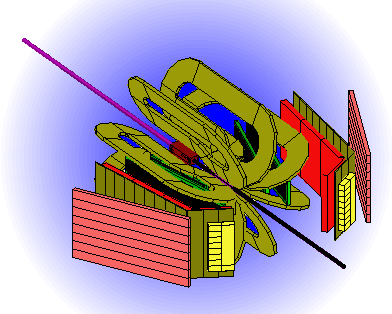
Scattering of polarized circulating electrons from polarized internal target is an important capability for intermediate energy nuclear physics. It makes possible the full exploitation of spin observable in electronuclear processes. This new technology has recently become available to experimentalists in the US after the completion of the MIT-Bates South Hall Ring. In order to maximize the scientific output of this facility, the BLAST detection system is well matched to the characteristics of the electron beam and nuclear targets.
The design of the BLAST detector consists of an eight sector copper coil array which produces a toroidal magnetic field, instrumented with two opposing wedge-shaped sectors of wire chambers, scintillation detectors, Cerenkov counters, lead glass calorimeter and neutron detectors. The open geometry maximizes acceptance while allowing good momentum and angular resolution and a luminosity capability matched to the projected densities of the polarized internal targets. Clear upgrade possibilities exist so that the detector can evolve to match developing physics priorities.
The scientific goals are pursued through comprehensive and simultaneous measurements for various reaction channels. Consequently, experimental data are obtained with redundancy and reduced systematic errors. The determination of significant but small quantities, like the charge structure of the neutron, is then based on a solid understanding of the ground state spin structure and the details of the reaction mechanism.
In summary, BLAST is able to provide new capabilities in the study of the electromagnetic response of nuclei in the energy regime up to 1 GeV.
